Prediction of Shape Change for Fatigue Crack in a Round Bar Using Three-Parameter Growth Circles
Abstract
:Featured Application
Abstract
1. Introduction
2. Numerical Propagation Process
2.1. Three-Parameter Model
2.2. Fatigue Crack Propagation
2.3. Numerical Simulation
3. Results and Discussion
3.1. Evolution of the Crack Shape
3.2. Comparison with Other Numerical Solutions and Experimental Results
4. Conclusions
- The crack growth circles method is developed for the surface cracks of a round bar, and the circles are tangent to both current and new crack fronts. In this way, good simulation accuracy can be achieved with fewer iterations.
- A three-parameter model with fewer shape restraints whose center is allowed to move along the vertical axis is built, and the shape change of a fatigue crack is predicted more precisely. The nominal aspect ratio of an ellipse, which is the ratio of the maximum crack depth to the chord length , , is considered, instead of the actual aspect ratio of an ellipse semi-axis.
- A relatively large crack growth increment can be used by adopting the equivalent stress intensity factor based on the stress intensity factors along the current and new crack fronts.
- The crack propagation process is described accurately based on the ratio of vertical growth toward the horizontal surface. It can be seen that the crack propagation paths differ with different initial flaws, but will converge asymptotically. The ratio of crack growth is always less than 1 for the case of initial crack , and the crack growth along the vertical central line is always greater than the growth toward the horizontal surface. For the case of an initial crack , a greater Paris law exponent m value generates more drastic change.
- The present solutions are compared with other numerical solutions and experimental data. Comparison shows that the present solutions agree well with the experimental data and are better than other numerical solutions.
Author Contributions
Funding
Conflicts of Interest
Nomenclature
| Diameter of round bar | Stress intensity factor range | ||
| Major axis of an ellipse | Equivalent stress intensity factor | ||
| Minor axis of an ellipse | Stepping coefficient | ||
| Center of ellipse | Crack growth length in Equation (4) | ||
| Chord length of an ellipse | Distance in Equation (7) | ||
| Semi-axes of ellipse for i-th loading step | Actual aspect ratio | ||
| , | Semi-axes of ellipse for i + 1-th loading step | Nominal aspect ratio | |
| Center of ellipse for i + 1-th loading step | Relative crack depth | ||
| Coordinate for points , , , and | Relative chord length | ||
| Crack growth rate | Ratio of growth | ||
| , | Constants of the Paris–Erdogan law |
References
- Athanassiadis, A.; Boissenot, J.M.; Brevet, P.; Francois, D.; Raharinaivo, A. Linear elastic fracture mechanics computations of cracked cylindrical tensioned bodies. Int. J. Fract. 1981, 17, 553–566. [Google Scholar] [CrossRef]
- Nezu, K.; Machida, S.; Nakamura, H. Stress intensity factor of surface cracks and fatigue crack propagation behavior in a cylindrical bar. In Proceedings of the 25th Japan Congress on Material Research, Metallic Metals, Kyoto, Japan, 25–28 March 1982; pp. 87–92. [Google Scholar]
- Mackay, T.L.; Alperin, B.J. Stress intensity factors for fatigue cracking in high-strength bolts. Eng. Fract. Mech. 1985, 21, 391–397. [Google Scholar] [CrossRef]
- Lorentzen, T.; Kjaer, N.E.; Henriksen, T.K. The application of fracture mechanics to surface cracks in shafts. Eng. Fract. Mech. 1986, 23, 1005–1014. [Google Scholar] [CrossRef]
- Forman, R.G.; Shivakumar, V. Growth behavior of surface cracks in the circumferential plane of solid and hollow cylinders. In Fracture Mechanics: Seventeen Volume; American Society of Testing and Materials: Conshohocken, PA, USA, 1986; pp. 59–74. [Google Scholar]
- Caspers, M.; Mattheck, C.; Munz, D. Propagation of surface cracks in Notched and Unnotched Rods. In Surface-Crack Growth: Models, Experiments, and Structures; American Society of Testing and Materials: Conshohocken, PA, USA, 1990; pp. 365–389. [Google Scholar]
- Caspers, M.; Mattheck, C. Weighted averaged stress intensity factors of circular-fronted cracks in cylindrical bars. Fatigue Eng. Mater. Struct. 1987, 9, 329–341. [Google Scholar] [CrossRef]
- Ael din, S.S.; Lovegrove, J.M. Stress intensity factors for fatigue cracking of round bars. Int. J. Fatigue 1981, 3, 117–123. [Google Scholar]
- Carpinteri, A. Elliptical-arc surface cracks in round bars. Fatigue Eng. Mater. Struct. 1992, 15, 1141–1153. [Google Scholar] [CrossRef]
- Carpinteri, A.; Brighenti, R. Fatigue propagation of surface flaws in round bars: A three-parameter theoretical model. Fatigue Eng. Mater. Struct. 1996, 19, 1471–1480. [Google Scholar] [CrossRef]
- Carpinteri, A.; Brighenti, R.; Vantadori, S. Surface cracks in notched round bars under cyclic tension and bending. Int. J. Fatigue 2006, 28, 251–260. [Google Scholar] [CrossRef]
- Carpinteri, A. Shape change of surface cracks in round bars under cyclic axial loading. Int. J. Fatigue 1993, 15, 21–26. [Google Scholar] [CrossRef]
- Carpinteri, A.; Ronchei, C.; Vantadori, S. Stress intensity factors and fatigue growth of surface cracks in notched shell and round bars: Two decades of research work. Fatigue Fract. Eng. Mater. Struct. 2013, 36, 1–13. [Google Scholar] [CrossRef]
- Carpinteri, A.; Vantadori, S. Surface crack in round bars under cyclic tension or bending. Key Eng. Mater. 2008, 378–379, 341–354. [Google Scholar] [CrossRef]
- Couroneau, N.; Royer, J. Simplified model for the fatigue growth analysis of surface cracks in round bars under mode I. Int. J. Fatigue 1998, 20, 711–718. [Google Scholar] [CrossRef]
- Carpinteri, A.; Vantadori, S. Sickle-shaped surface crack in a notched round bar under cyclic tension and bending. Fatigue Fract. Eng. Mater. Struct. 2009, 32, 223–232. [Google Scholar] [CrossRef]
- Ayhan, A.O. Simulation of three-dimensional fatigue crack propagation using enriched finite elements. Comput. Struct. 2011, 89, 801–812. [Google Scholar] [CrossRef]
- Shin, C.S.; Cai, C.Q. Experimental and finite element analyses on stress intensity factors of an elliptical surface crack in a circular shaft under tension and bending. Int. J. Fatigue 2004, 129, 239–264. [Google Scholar] [CrossRef]
- Yang, F.P.; Kuang, Z.B.; Shlyannikov, V.N. Fatigue crack growth for straight-fronted edge crack in a round bar. Int. J. Fatigue 2006, 28, 431–437. [Google Scholar] [CrossRef]
- Cai, C.Q.; Shin, C.S. A normalized area-compliance method for monitoring surface crack development in a cylindrical rod. Int. J. Fatigue 2005, 27, 801–809. [Google Scholar] [CrossRef]
- Liu, C.; Chu, S. Prediction of shape change of corner crack by fatigue crack growth circles. Int. J. Fatigue 2015, 75, 80–88. [Google Scholar] [CrossRef]
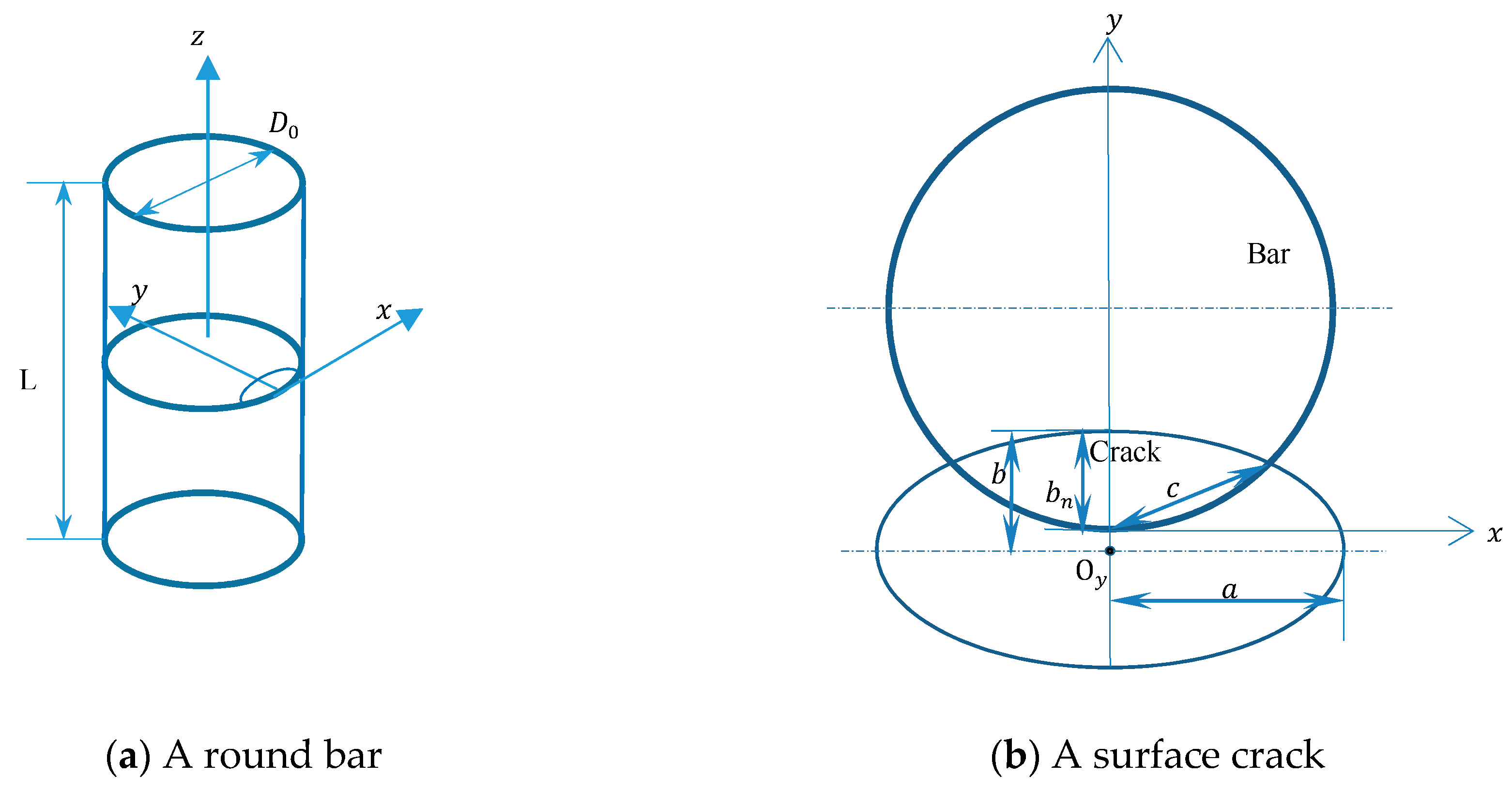

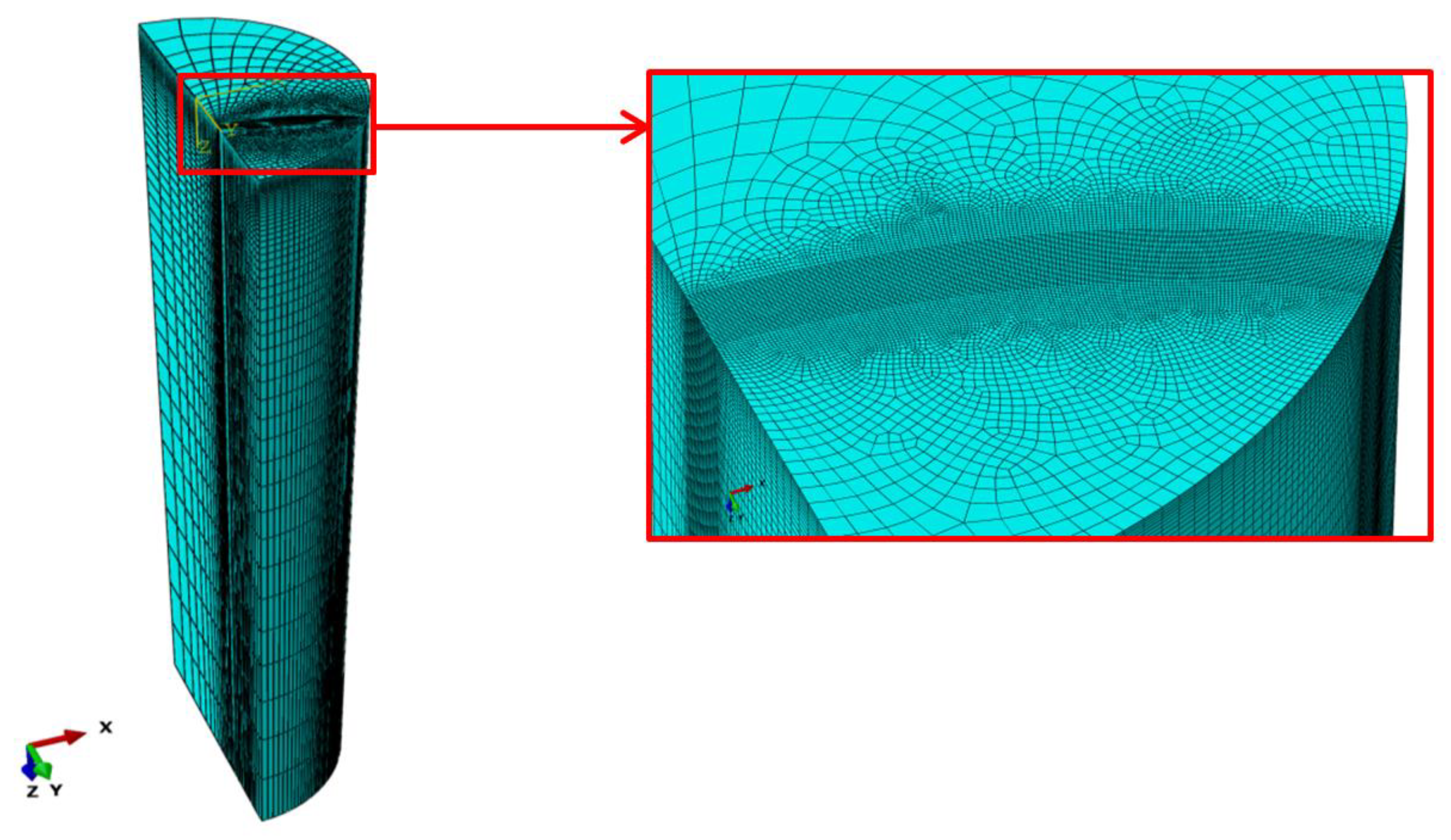
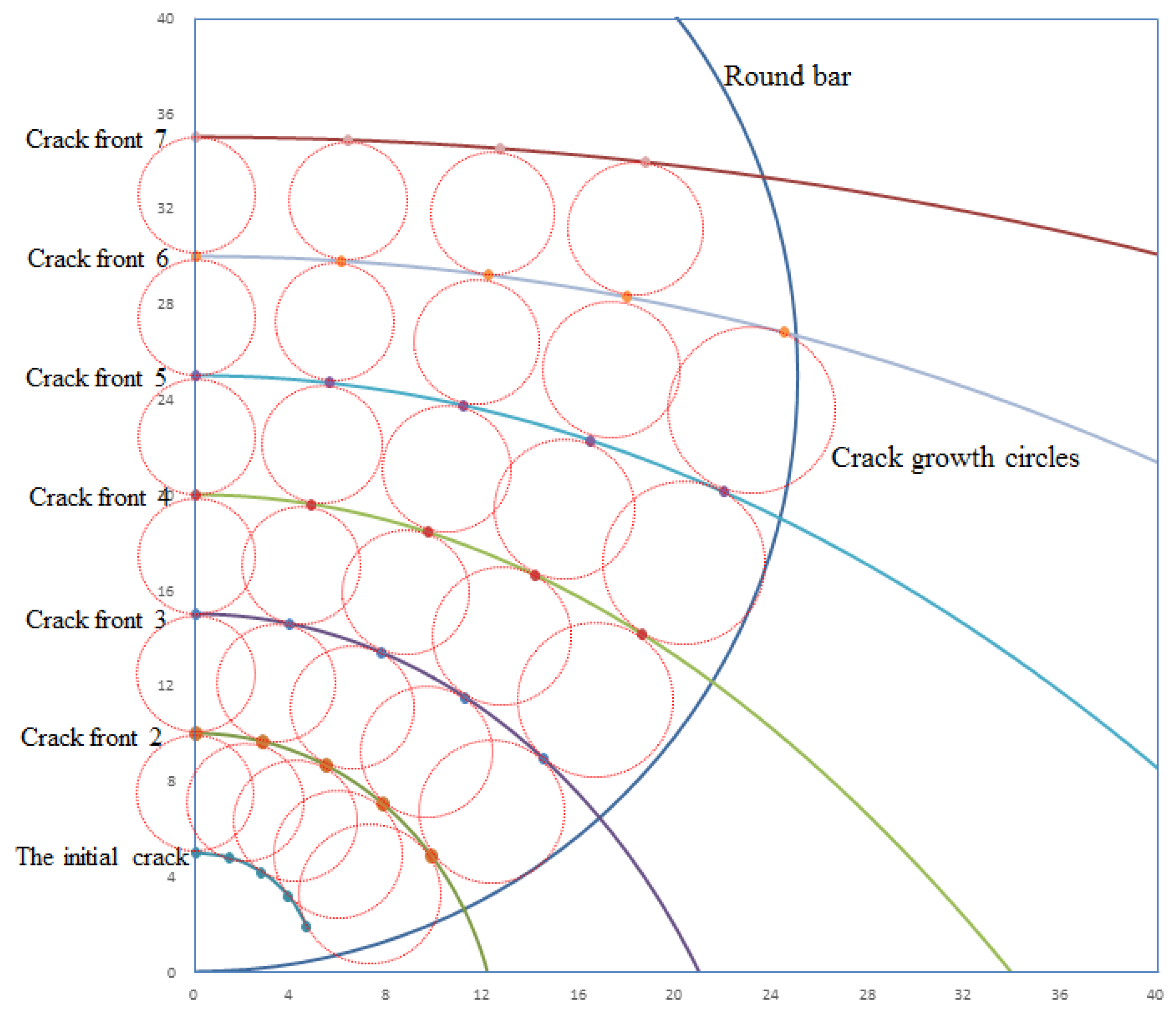


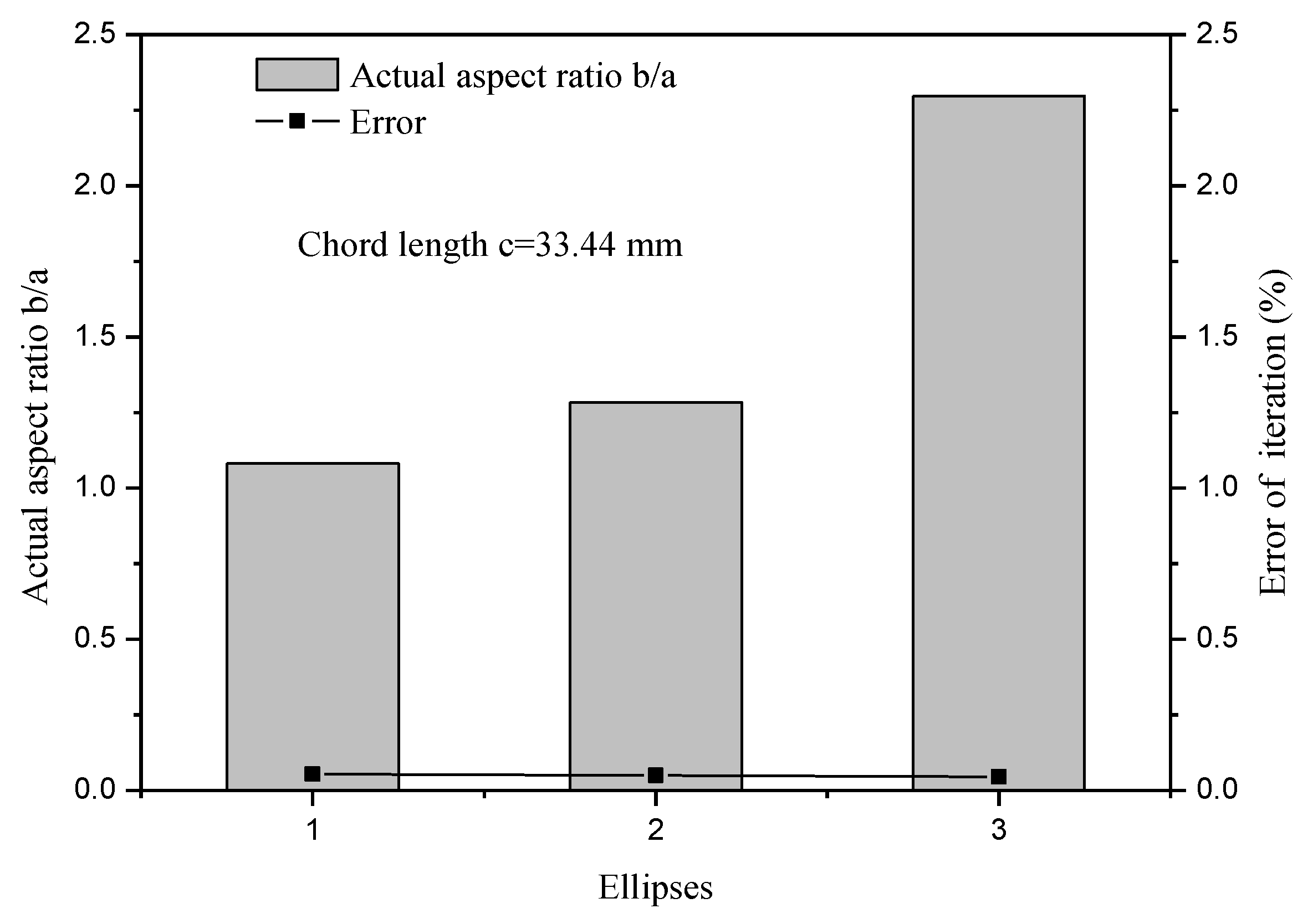
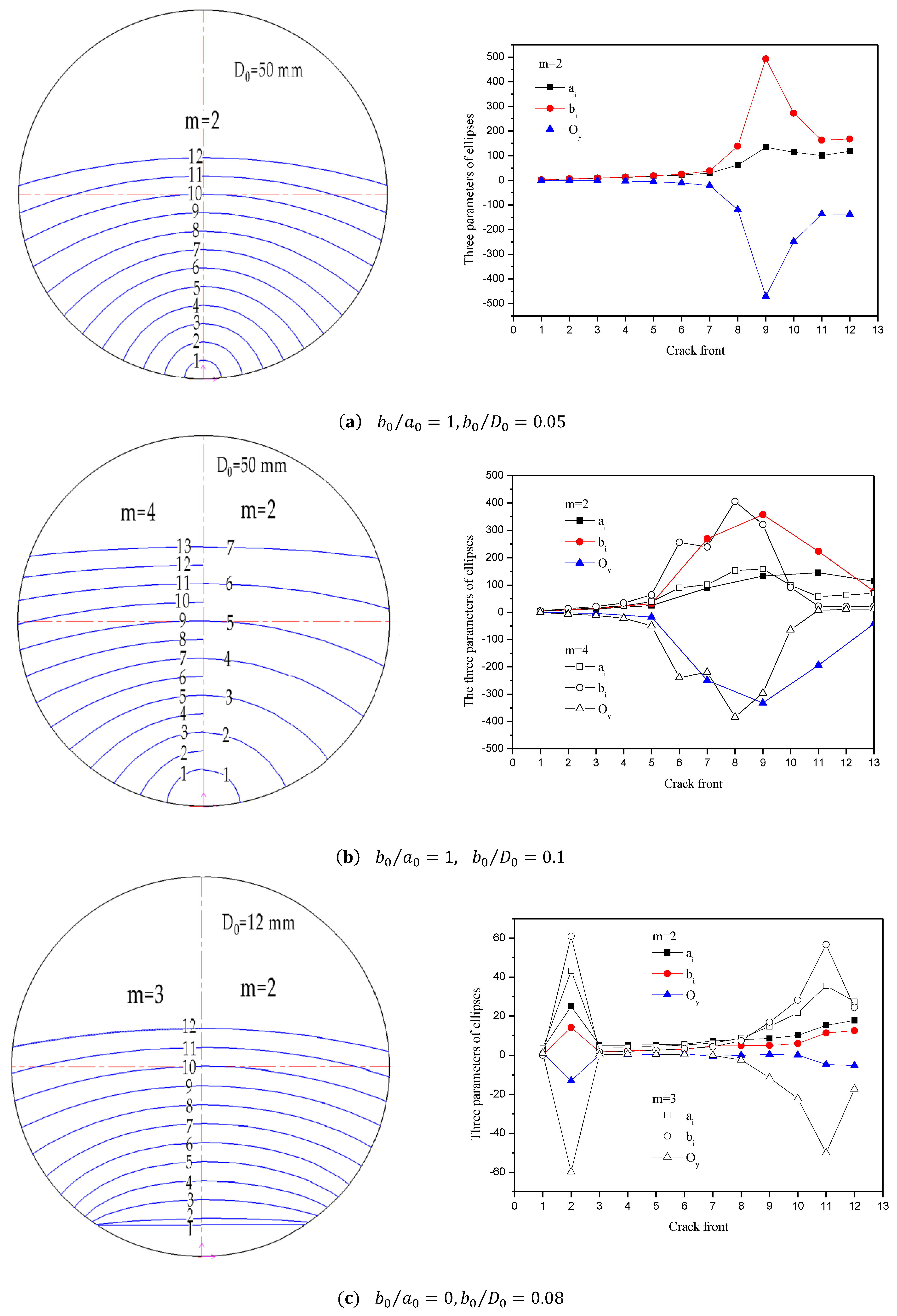

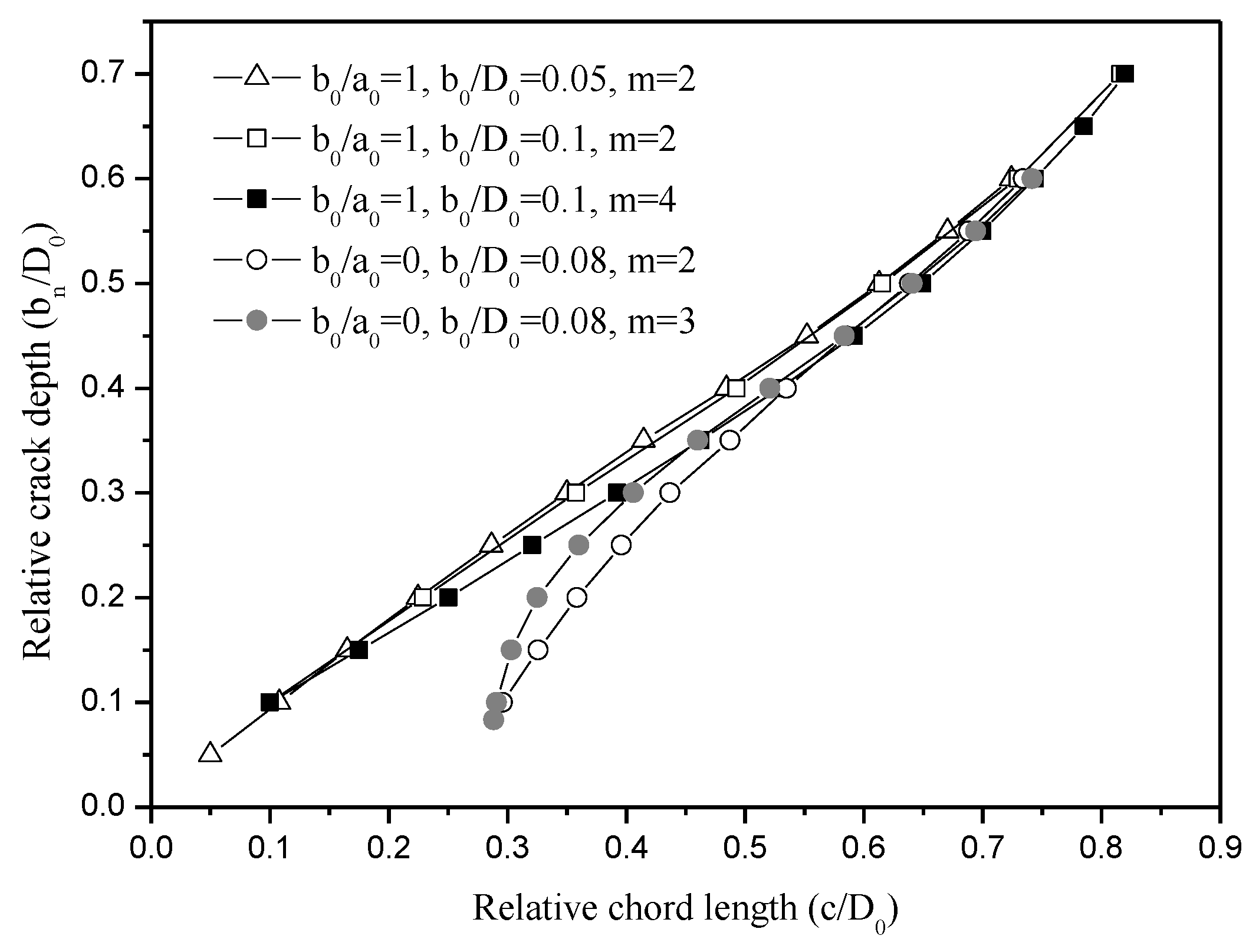

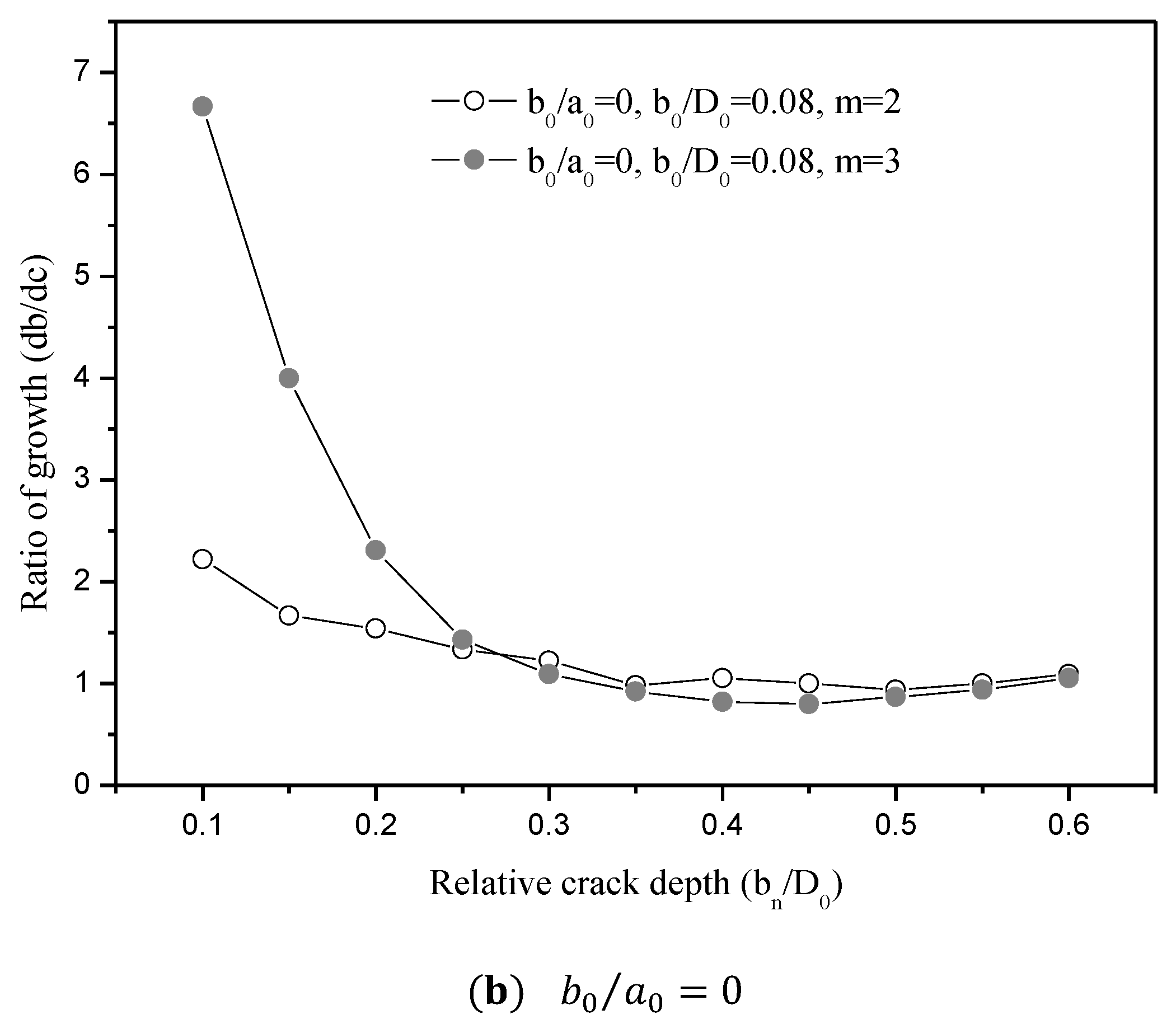
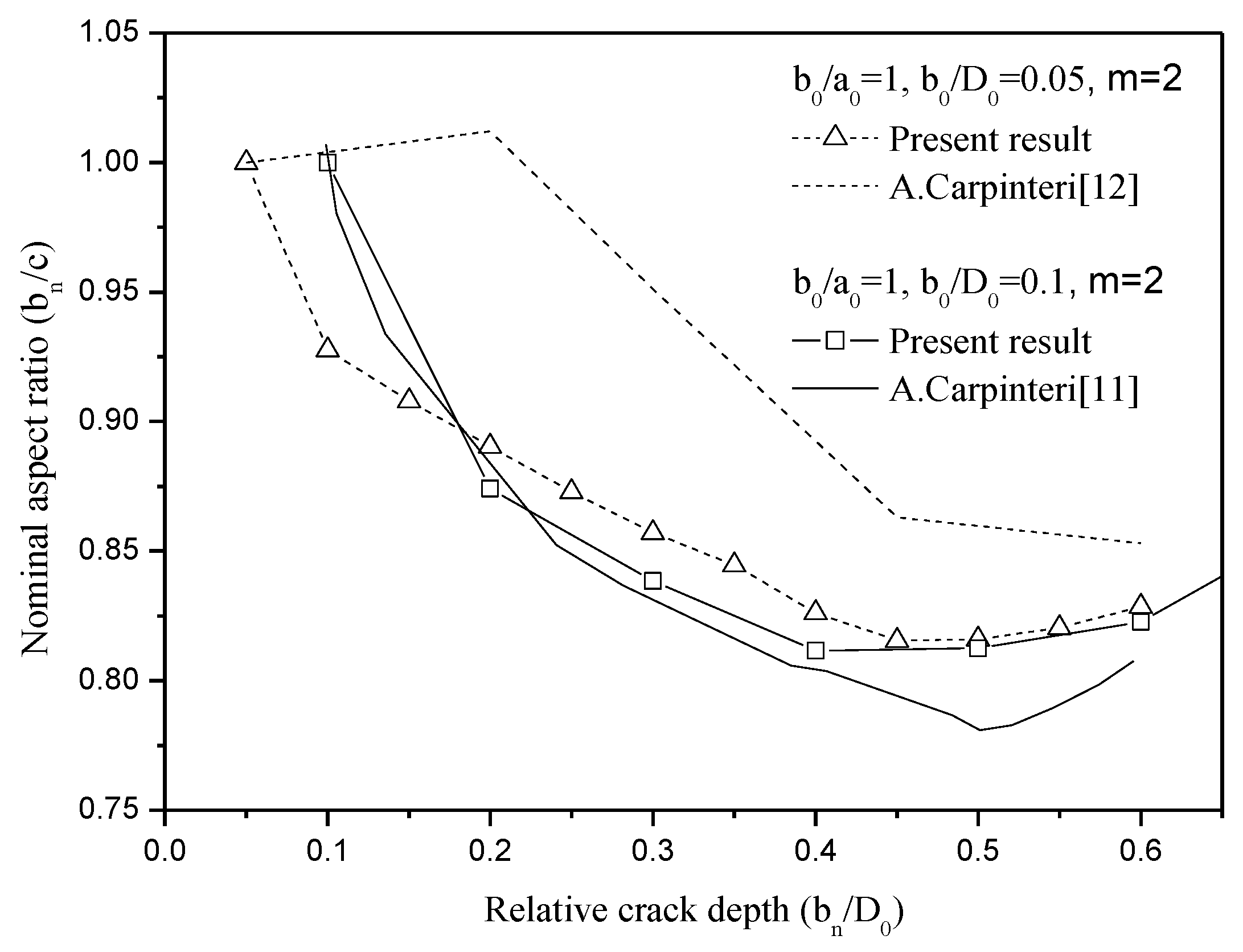

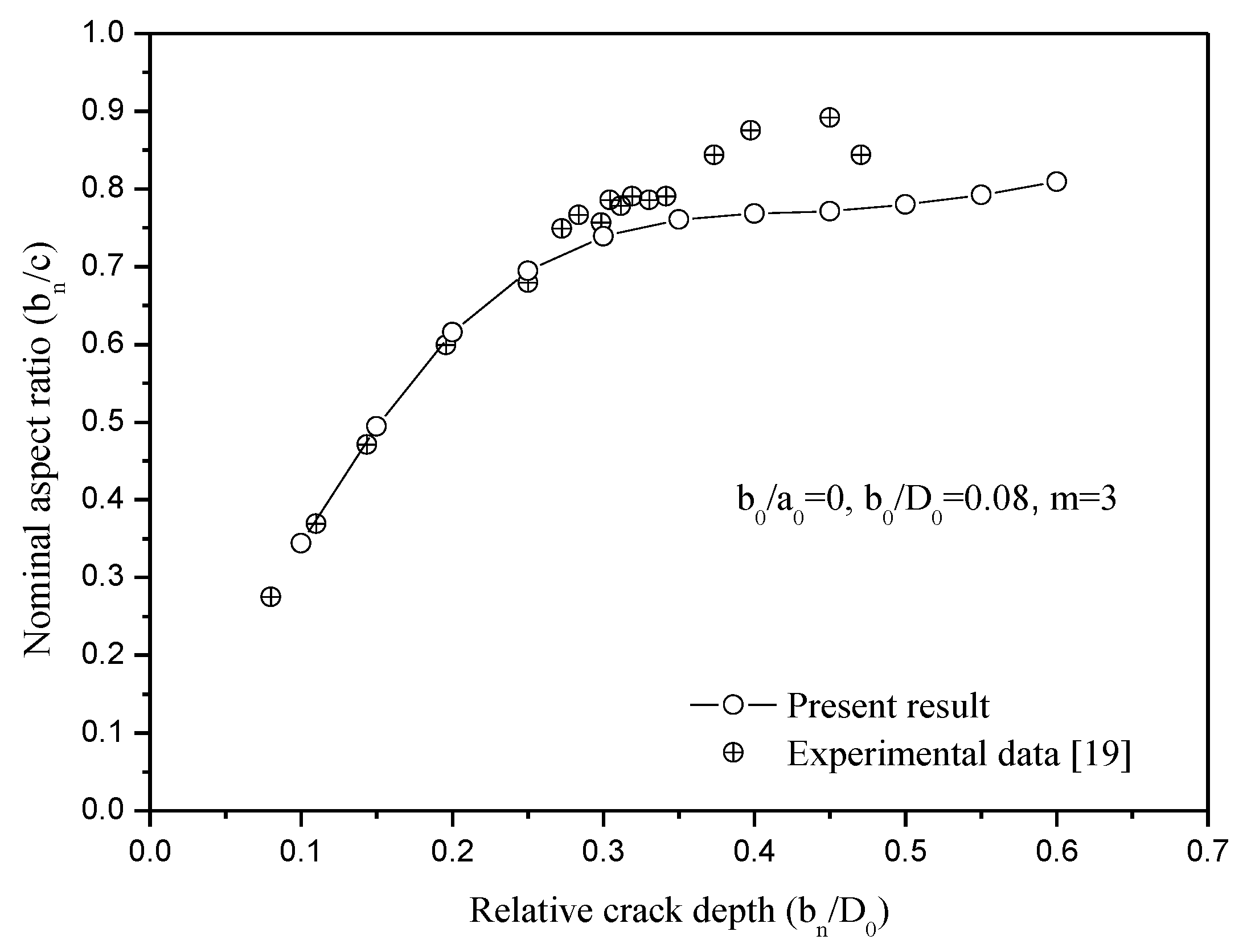
| Monotonic Tensile Yield Strength | Nominal Ultimate Tensile Strength | True Ultimate Tensile Strength | Young’s Modulus | Poisson’s Ratio | Crack Growth Parameter |
|---|---|---|---|---|---|
| 2.06 × 105 MPa | 0.33 | 3 |
© 2019 by the authors. Licensee MDPI, Basel, Switzerland. This article is an open access article distributed under the terms and conditions of the Creative Commons Attribution (CC BY) license (http://creativecommons.org/licenses/by/4.0/).
Share and Cite
Yang, Y.; Chu, S.; Chen, H. Prediction of Shape Change for Fatigue Crack in a Round Bar Using Three-Parameter Growth Circles. Appl. Sci. 2019, 9, 1751. https://doi.org/10.3390/app9091751
Yang Y, Chu S, Chen H. Prediction of Shape Change for Fatigue Crack in a Round Bar Using Three-Parameter Growth Circles. Applied Sciences. 2019; 9(9):1751. https://doi.org/10.3390/app9091751
Chicago/Turabian StyleYang, Yali, Seokjae Chu, and Hao Chen. 2019. "Prediction of Shape Change for Fatigue Crack in a Round Bar Using Three-Parameter Growth Circles" Applied Sciences 9, no. 9: 1751. https://doi.org/10.3390/app9091751





